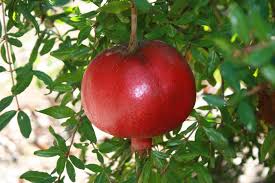Move over, apples!
Pomegranates are loaded with phytonutrients with powerful health benefits. Not to mention, tasty! And quite moderate in calories, about 80 – 85 apiece.
Prevents heart disease: Pomegranates contain antioxidants which prevent free radical damage of the walls of arteries, thus preventing heart disease. They also prevent oxidation of cholesterol, which causes plaque formation and development of coronary artery disease.
Lowers blood pressure: Punicic acid is one of the main constituents of pomegranates that help lower cholesterol, triglycerides and reduce blood pressure.
May help prevent cancer Pomegranates can help in prevention and also in the treatment of several forms of cancer.
Helps digestion Eating a pomegranate every day is a good way to add fibre to your daily diet. One pomegranate can fulfil about 45% of the daily recommended intake of fibre, which is about 25 to 35g.
Improves immunity: Being rich in anti-inflammatory compounds, pomegranates are extremely healthy for those suffering from immune-related disorders like rheumatoid arthritis and osteoarthritis, and also for a generally healthy immune system and to stave off common illnesses and infections. They are also rich in vitamin C, which boosts antibody production and development of immunity.
Appear younger Polyphenolic compounds in pomegranates are powerful antioxidants that can delay the process of aging. Therefore, eating pomegranate keeps your skin glowing and radiant for a long time.
Lowers stress levels: Apart from reducing the body’s internal oxidative stress, pomegranates also help lower psychological stress. According to a study, people who drank pomegranate juice had lower levels of cortisol, a stress hormone that is increased under stressful situations.
Keeps Alzheimer’s at bay: A study showed that pomegranate juice reduces the deposition and accumulation of plaque in the brain by 50%.
All of these health benefits make pomegranate a great addition to your diet. Its easy to pack to carry along and lends itself well to adding to a salad, or smoothie, or yogurt parfait. Get creative!
And Stay Healthy!













